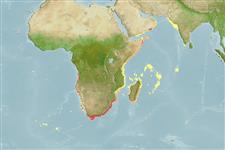ກຸ່ມປາກະດູກອ່ອນ (ເຊັ່ນ: ປາສະຫລາມ, ປາຜາໄລ) (sharks and rays) >
Myliobatiformes (Stingrays) >
Gymnuridae (Butterfly rays)
Etymology: Gymnura: Greek, gymnos = naked + Greek, oura = tail (Ref. 45335).
More on authors: Gilchrist & Thompson.
Environment: milieu / climate zone / depth range / distribution range
ນິເວດວິທະຍາ
ສັດທະເລ ອາໄສຢູ່ໃກ້ໜ້າດິນໃຕ້ພື້ນທ້ອງນ້ຳ; ລະດັບຄວາມເລິກ 20 - 100 m (Ref. 28016). Subtropical
Southeast Atlantic and Western Indian Ocean: Namibia round the Cape to southern Mozambique.
Length at first maturity / ຂະໜາດ / ນ້ຳໜັກ / Age
Maturity: Lm ?, range 150 - ? cm
Max length : 250 cm WD ຕົວຜູ້/ບໍ່ມີເພດ; (Ref. 3263); ນ້ຳໜັກສູງສຸດທີ່ເຄຍຈັດພີມມາ: 82.6 kg (Ref. 40637)
ຄີ (ໜາມ)ແຂງຢູ່ຫຼັງປາ (ທັງໝົດ) : 0. Broad diamond-shaped pectoral disc almost twice as wide as it is long; tail shorter than body with black and white bands and a small sting; tentacle at rear edge of each spiracle (Ref. 5578). Grey, green or brown above, often with darker mottling; white below; can change color of upper disc rapidly to match substrate (Ref. 5578).
Occurs off sandy beaches, muddy estuaries and offshore banks. Found singly or in large groups (Ref. 5578). Feeds on a variety of fishes, crabs and polychaete worms (Ref. 5578). Ovoviviparous (Ref. 50449). Ability to change markings and color to blend into environment (Ref. 3263). Caught by offshore trawlers (Ref. 5578). Caught by shore anglers, it is prized for its strong fight when hooked, often released (Ref. 5578).
Exhibit ovoviparity (aplacental viviparity), with embryos feeding initially on yolk, then receiving additional nourishment from the mother by indirect absorption of uterine fluid enriched with mucus, fat or protein through specialised structures (Ref. 50449). Distinct pairing with embrace (Ref. 205). One year gestation; up to 10 young (Ref. 5578).
Compagno, L.J.V., 1986. Dasyatidae. p. 135-142. In M.M. Smith and P.C. Heemstra (eds.) Smiths' sea fishes. Springer-Verlag, Berlin. (Ref. 3263)
IUCN Red List Status (Ref. 130435)
Threat to humans
Harmless
Human uses
ຊະນິດປາທີ່ຖືກນຳໃຊ້ເຂົ້າໃນການຫາເພື່ອເປັນເກມກິລາ: ແມ່ນ
ເຄື່ອງມື
Special reports
Download XML
ແຫຼ່ງອີນເຕີເນັດ
Estimates based on models
Preferred temperature (Ref.
123201): 14.5 - 27.1, mean 25.3 °C (based on 72 cells).
Phylogenetic diversity index (Ref.
82804): PD
50 = 0.5000 [Uniqueness, from 0.5 = low to 2.0 = high].
Bayesian length-weight: a=0.00776 (0.00352 - 0.01710), b=3.09 (2.89 - 3.29), in cm total length, based on LWR estimates for this (Sub)family-body shape (Ref.
93245).
ຊັ້ນເຂດຮ້ອນ (Ref.
69278): 3.9 ±0.65 se; based on food items.
ຄວາມຢືດຢຸ່ນ (Ref.
120179): ຕຳ່ຫຼາຍ, ປະຊາກອນຕຳ່ສຸດທີ່ໃຊ້ເວລາສອງເທົ່າຫຼາຍກວ່າ 14 ປີ (Fec=10).
Fishing Vulnerability (Ref.
59153): Moderate to high vulnerability (51 of 100).
